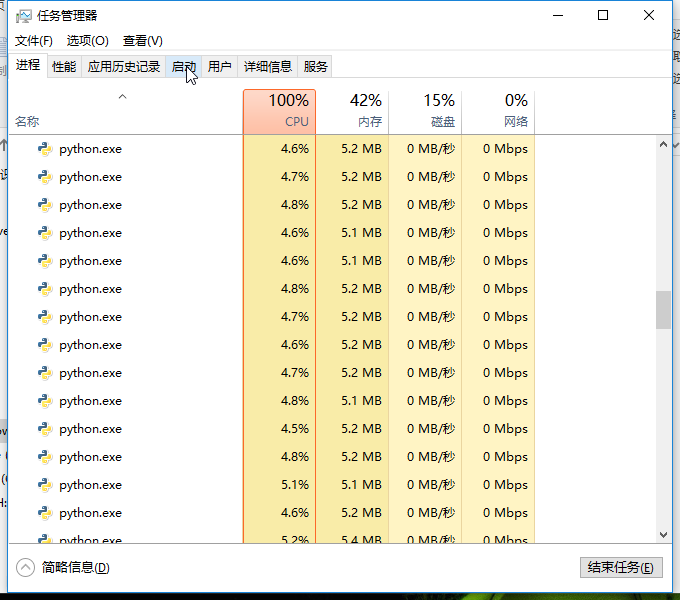对比实验
资料显示,如果多线程的进程是CPU密集型的,那多线程并不能有多少效率上的提升,相反还可能会因为线程的频繁切换,导致效率下降,推荐使用多进程;如果是IO密集型,多线程进程可以利用IO阻塞等待时的空闲时间执行其他线程,提升效率。所以我们根据实验对比不同场景的效率
| 操作系统 | CPU | 内存 | 硬盘 |
|-----------|-------|------|--------|
| Windows 10 | 双核 |8GB|机械硬盘|
(1)引入所需要的模块
import requests import time from threading import Thread from multiprocessing import Process
(2)定义CPU密集的计算函数
def count(x, y):
# 使程序完成150万计算
c = 0
while c < 500000:
c += 1
x += x
y += y(3)定义IO密集的文件读写函数
def write():
f = open("test.txt", "w")
for x in range(5000000):
f.write("testwrite\n")
f.close()
def read():
f = open("test.txt", "r")
lines = f.readlines()
f.close()(4) 定义网络请求函数
_head = {
'User-Agent': 'Mozilla/5.0 (Windows NT 10.0; WOW64) AppleWebKit/537.36 (KHTML, like Gecko) Chrome/48.0.2564.116 Safari/537.36'}
url = "http://www.tieba.com"
def http_request():
try:
webPage = requests.get(url, headers=_head)
html = webPage.text
return {"context": html}
except Exception as e:
return {"error": e}(5)测试线性执行IO密集操作、CPU密集操作所需时间、网络请求密集型操作所需时间
# CPU密集操作
t = time.time()
for x in range(10):
count(1, 1)
print("Line cpu", time.time() - t)
# IO密集操作
t = time.time()
for x in range(10):
write()
read()
print("Line IO", time.time() - t)
# 网络请求密集型操作
t = time.time()
for x in range(10):
http_request()
print("Line Http Request", time.time() - t)输出
CPU密集:95.6059999466、91.57099986076355 92.52800011634827、 99.96799993515015
IO密集:24.25、21.76699995994568、21.769999980926514、22.060999870300293
网络请求密集型: 4.519999980926514、8.563999891281128、4.371000051498413、4.522000074386597、14.671000003814697
(6)测试多线程并发执行CPU密集操作所需时间
counts = []
t = time.time()
for x in range(10):
thread = Thread(target=count, args=(1,1))
counts.append(thread)
thread.start()
e = counts.__len__()
while True:
for th in counts:
if not th.is_alive():
e -= 1
if e <= 0:
break
print(time.time() - t)Output: 99.9240000248 、101.26400017738342、102.32200002670288
(7)测试多线程并发执行IO密集操作所需时间
def io():
write()
read()
t = time.time()
ios = []
t = time.time()
for x in range(10):
thread = Thread(target=count, args=(1,1))
ios.append(thread)
thread.start()
e = ios.__len__()
while True:
for th in ios:
if not th.is_alive():
e -= 1
if e <= 0:
break
print(time.time() - t)Output: 25.69700002670288、24.02400016784668
(8)测试多线程并发执行网络密集操作所需时间
t = time.time()
ios = []
t = time.time()
for x in range(10):
thread = Thread(target=http_request)
ios.append(thread)
thread.start()
e = ios.__len__()
while True:
for th in ios:
if not th.is_alive():
e -= 1
if e <= 0:
break
print("Thread Http Request", time.time() - t)Output: 0.7419998645782471、0.3839998245239258、0.3900001049041748
(9)测试多进程并发执行CPU密集操作所需时间
counts = []
t = time.time()
for x in range(10):
process = Process(target=count, args=(1,1))
counts.append(process)
process.start()
e = counts.__len__()
while True:
for th in counts:
if not th.is_alive():
e -= 1
if e <= 0:
break
print("Multiprocess cpu", time.time() - t)Output: 54.342000007629395、53.437999963760376
(10)测试多进程并发执行IO密集型操作
t = time.time()
ios = []
t = time.time()
for x in range(10):
process = Process(target=io)
ios.append(process)
process.start()
e = ios.__len__()
while True:
for th in ios:
if not th.is_alive():
e -= 1
if e <= 0:
break
print("Multiprocess IO", time.time() - t)Output: 12.509000062942505、13.059000015258789
(11)测试多进程并发执行Http请求密集型操作
t = time.time()
httprs = []
t = time.time()
for x in range(10):
process = Process(target=http_request)
ios.append(process)
process.start()
e = httprs.__len__()
while True:
for th in httprs:
if not th.is_alive():
e -= 1
if e <= 0:
break
print("Multiprocess Http Request", time.time() - t)Output: 0.5329999923706055、0.4760000705718994
实验结果

通过上面的结果,我们可以看到:
多线程在IO密集型的操作下似乎也没有很大的优势(也许IO操作的任务再繁重一些就能体现出优势),在CPU密集型的操作下明显地比单线程线性执行性能更差,但是对于网络请求这种忙等阻塞线程的操作,多线程的优势便非常显著了
多进程无论是在CPU密集型还是IO密集型以及网络请求密集型(经常发生线程阻塞的操作)中,都能体现出性能的优势。不过在类似网络请求密集型的操作上,与多线程相差无几,但却更占用CPU等资源,所以对于这种情况下,我们可以选择多线程来执行

 您如何切成python列表?May 02, 2025 am 12:14 AM
您如何切成python列表?May 02, 2025 am 12:14 AMSlicingaPythonlistisdoneusingthesyntaxlist[start:stop:step].Here'showitworks:1)Startistheindexofthefirstelementtoinclude.2)Stopistheindexofthefirstelementtoexclude.3)Stepistheincrementbetweenelements.It'susefulforextractingportionsoflistsandcanuseneg
 在Numpy阵列上可以执行哪些常见操作?May 02, 2025 am 12:09 AM
在Numpy阵列上可以执行哪些常见操作?May 02, 2025 am 12:09 AMnumpyallowsforvariousoperationsonArrays:1)basicarithmeticlikeaddition,减法,乘法和division; 2)evationAperationssuchasmatrixmultiplication; 3)element-wiseOperations wiseOperationswithOutexpliitloops; 4)
 Python的数据分析中如何使用阵列?May 02, 2025 am 12:09 AM
Python的数据分析中如何使用阵列?May 02, 2025 am 12:09 AMArresinpython,尤其是Throughnumpyandpandas,weessentialFordataAnalysis,offeringSpeedAndeffied.1)NumpyArseNable efflaysenable efficefliceHandlingAtaSetSetSetSetSetSetSetSetSetSetSetsetSetSetSetSetsopplexoperationslikemovingaverages.2)
 列表的内存足迹与python数组的内存足迹相比如何?May 02, 2025 am 12:08 AM
列表的内存足迹与python数组的内存足迹相比如何?May 02, 2025 am 12:08 AM列表sandnumpyArraysInpyThonHavedIfferentMemoryfootprints:listSaremoreFlexibleButlessMemory-效率,而alenumpyArraySareSareOptimizedFornumericalData.1)listsStorReereReereReereReereFerenceStoObjects,withoverHeadeBheadaroundAroundaroundaround64bytaround64bitson64-bitsysysysyssyssyssyssyssyssysssys2)
 部署可执行的Python脚本时,如何处理特定环境的配置?May 02, 2025 am 12:07 AM
部署可执行的Python脚本时,如何处理特定环境的配置?May 02, 2025 am 12:07 AMtoensurepythonscriptsbehavecorrectlyacrycrossdevelvermations,登台和生产,USETHESTERTATE:1)Environment varriablesforsimplesettings,2)configurationFilesForefilesForcomPlexSetups,3)dynamiCofforAdaptapity.eachmethodofferSuniquebeneiquebeneiquebeneniqueBenefitsaniqueBenefitsandrefitsandRequiresandRequireSandRequireSca
 您如何切成python阵列?May 01, 2025 am 12:18 AM
您如何切成python阵列?May 01, 2025 am 12:18 AMPython列表切片的基本语法是list[start:stop:step]。1.start是包含的第一个元素索引,2.stop是排除的第一个元素索引,3.step决定元素之间的步长。切片不仅用于提取数据,还可以修改和反转列表。
 在什么情况下,列表的表现比数组表现更好?May 01, 2025 am 12:06 AM
在什么情况下,列表的表现比数组表现更好?May 01, 2025 am 12:06 AMListSoutPerformarRaysin:1)DynamicsizicsizingandFrequentInsertions/删除,2)储存的二聚体和3)MemoryFeliceFiceForceforseforsparsedata,butmayhaveslightperformancecostsinclentoperations。
 如何将Python数组转换为Python列表?May 01, 2025 am 12:05 AM
如何将Python数组转换为Python列表?May 01, 2025 am 12:05 AMtoConvertapythonarraytoalist,usEthelist()constructororageneratorexpression.1)intimpthearraymoduleandcreateanArray.2)USELIST(ARR)或[XFORXINARR] to ConconverTittoalist,请考虑performorefformanceandmemoryfformanceandmemoryfformienceforlargedAtasetset。


热AI工具

Undresser.AI Undress
人工智能驱动的应用程序,用于创建逼真的裸体照片

AI Clothes Remover
用于从照片中去除衣服的在线人工智能工具。

Undress AI Tool
免费脱衣服图片

Clothoff.io
AI脱衣机

Video Face Swap
使用我们完全免费的人工智能换脸工具轻松在任何视频中换脸!

热门文章

热工具

SublimeText3汉化版
中文版,非常好用

VSCode Windows 64位 下载
微软推出的免费、功能强大的一款IDE编辑器

Dreamweaver CS6
视觉化网页开发工具

Dreamweaver Mac版
视觉化网页开发工具

SublimeText3 Linux新版
SublimeText3 Linux最新版





